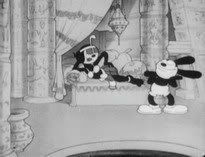Case of the Missing Hare
Case of the Missing Hare (12/12/1942) is one of the better known early Bugs Bunny cartoons, thanks to its public domain status. It is also an important cartoon both for the development and refinement of Bugs Bunny's character, and for the career of its director Chuck Jones.

Chuck Jones started directing cartoons at WB in 1938, and his output during the first four years can be characterized as "hit and miss". His cartoons were pretty to look at, meticulously planned and nicely animated. Also, they were slow and not very funny, or sometimes not funny at all, especially when compared to the work of his colleagues. Disney's influence was absolutely dominant in these early Chuck Jones cartoons, both in the animation and the choice of subjects and stories. The humor tended to be of "slowburn" type - another great similarity with Disney cartoons (think of Goofy or Pluto). The culmination of this approach was the infamous 1940. misfire called Good Night Elmer.
All of this early work shows an ambitious and talented director who haven't yet found his own voice and style. However, things slowly started to change during the first half of 1942, with couple of funny and dynamic cartoons that used the already established WB stars: Conrad the Sailor (an excellent early Daffy Duck cartoon), and Hold the Lion Please, Chuck's first attempt at real Bugs Bunny cartoon. In these cartoons, we can finally see Jones successfully adapting himself to the Warner-style humor.
After creating his first real masterpiece with The Dover Boys, Chuck made his next two cartoons with Daffy & Bugs: My Favorite Duck and Case of the Missing Hare. Here Jones finally showed the confidence and complete understanding of these characters.
Case of the Missing Hare is especially significant, because it represents the blueprint for many other Bugs Bunny cartoons that Jones will direct for the rest of '40s and the early '50s. Also, I consider it as the real moment of birth for Chuck Jones' specific sense of humor and dynamic drawing style.
Jones will continue the experimentation from The Dover Boys in all his subsequent cartoons during the 1942-43 season, but in slightly less radical form. Here, we have some excellent stylized backgrounds (courtesy of the wonderfully innovative layout and background artists John McGrew and Eugene Fleury), and distorted, "smeary" in-betweens. The animators in this cartoon are Ken Harris, and probably Bob Cannon.



The magician Ala Bahma is the first in the series of "lummox" characters that Chuck Jones will use as the opponents for Bugs Bunny.




This is a very interesting pose and drawing - reminds me very much of Milt Gross:


A great example of distorted, "smeary" inbetweens, in "The Dover Boys" style:












"Of course, you realize this means war". The first time Bugs Bunny ever used this catchprase that will soon serve as a real formula. In Chuck Jones cartoons, Bugs reacts only after being provoked.

Very nice sense of depth in the next two images, achieved mostly with flat color areas:




Excellent choice of camera angles in the next two frames:


Nearly all the backgrounds in this second half of the cartoon consist of flat colors that represent the stylized versions of the stage curtains. Colors will change according to the action or mood. The poses and fast action really stand out in such simplified background style.






Looks almost like a drawing from a Clampett cartoon:




Excellent use of the "dry brush" effect for the fast action. Previously, Clampett experimented with this technique in Wacky Wabbit (check these screenshots on John K. blog) .







A goofy-looking "bumpkin" Bugs. Reminds me little bit of the proto-Bugs that Jones used in "Elmer's Candid Camera" and "Elmer's Pet Rabbit".



This is a great scene. Curtains change colors in the middle of the fast action. I was really fascinated with this bit, when I first saw this cartoon as a kid:







With exception of Clampett, none of the Warner directors payed too much attention to the lip synch animation (mostly, it consisted of the regular and routine lip movements). This is a very nice example of interesting lip synch and dialogue acting in Jones cartoon:









A very sick and funny joke :) I love this scene!











The following few images were still-framed for a second in the actual cartoon. Really wonderful and funny poses.





More dry brush effects, and more hilarious poses.












And that's the end! Great cartoon!
Labels: Bugs Bunny, Chuck Jones


3 Comments:
There's a lot of abstraction in the backgrounds. Are they by Paul Julian?
Stephen
5:22 pm
Actually I believe that the abstract backgrounds are by Ken Harris.
1:12 pm
I noticed alot of cool animation from by Bobe Cannon I just don't know which scenes, do know which scenes?(or at least anywone?)
11:26 pm
Post a Comment
<< Home